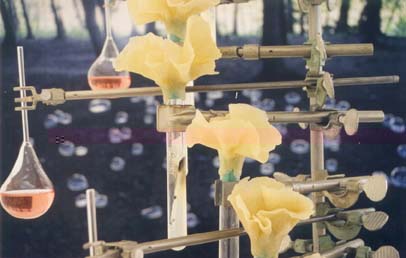Annie Thibault
dal 18/9/2001 al 21/10/2001
Segnalato da
Bishop's University Art Gallery
18/9/2001
Annie Thibault
Art Gallery Bishop, Lennoxville, QC
The Art Gallery of Bishop’s University is pleased to present "Animalcules et dessins obscurs," a site- specific installation by Annie Thibault. This body of work is part of an ongoing project called "La Chambre des Cultures" which began in 1995 and evolved during the course of the artists’ numerous residencies in different microbiological laboratories. The artworks presented in this exhibition resulted from a three-week residency in the Biology Department of Bishop’s University where the artist cultured fungal microorganisms and bacteria.

The Art Gallery of Bishop’s University is pleased to present "Animalcules et dessins obscurs," a site- specific installation by Annie Thibault.
This body of work is part of an ongoing project called "La Chambre des Cultures" which began in 1995 and evolved during the course of the artists’ numerous residencies in different microbiological laboratories. The artworks presented in this exhibition resulted from a three-week residency in the Biology Department of Bishop’s University where the artist cultured fungal microorganisms and bacteria. Appearing throughout the installation in test tubes, flasks and petrie dishes, these vibrantly coloured and richly textured life forms are microcosmic universes through which Thibault’s exploration into the origins of life unfolds. Although sterilization techniques are employed, the risk of contamination is always present and is emblematic of the potential invasion of chaos which, according to the artist, provides a rich source of creative energy that prompts her to explore alternate possibilities which inevitably redirect the artistic process.
Although much of her practice depends on scientific methods, early alchemist myths about the origins of life and its accompanying imagery pervade the artist’s imagination, providing the impetus for much of her investigations. While present-day scientific discourse tends to dissociate itself from its alchemist and vitalist roots which are believed to be tainted by superstition, for Thibault what is most compelling, is the fact that these initial cosmogonic inquiries were guided by the researcher’s spirituality and intuition.
A rhizomorphous network comprised of interconnected laboratory glassware is a metaphoric expression for the migration of life-forms, capturing the artist’s wonderment in the face of living matter’s incredible adaptability and ability to emerge in previously uninhabited territory. Beeswax sculptures reminiscent of marine algae and flower petals protrude from glass funnels affixed to ring stands. Fusing scientific instruments with sculpture, Thibault engages in the deconstruction of the artificial barriers between the scientific, natural and artistic realms.
Annie Thibault lives and works in Hull, Quebec. In 1989, she obtained her Bachelor of Fine Arts degree from the University of Quebec at Hull. A recipient of the Claudia De Hueck Fellowship in Art and Science in 1998, she was also recently awarded the gold medal for sculpture at the Jeux de la Francophonie.
Annie Thibault would like to thank Le Conseil des arts et des lettres du Québec for their support.
VERNISSAGE: Wednesday, September 19, 2001, 5-7 p.m.
Artist's talk: Thursday, September 20, 2001 at 1:00 p.m. at the Art Gallery of Bishop’s University
Annie Thibault will be available for interviews from Tuesday, September 18 to Friday, September 21,2001.
HOURS: Tuesday to Sunday from 12-5 p.m.
Admission is free
For further information or to book a tour of the exhibition please contact Allyson Adley (819) 822-9600, ext. 2687
Art Gallery of Bishop’s University
Lennoxville, QC



